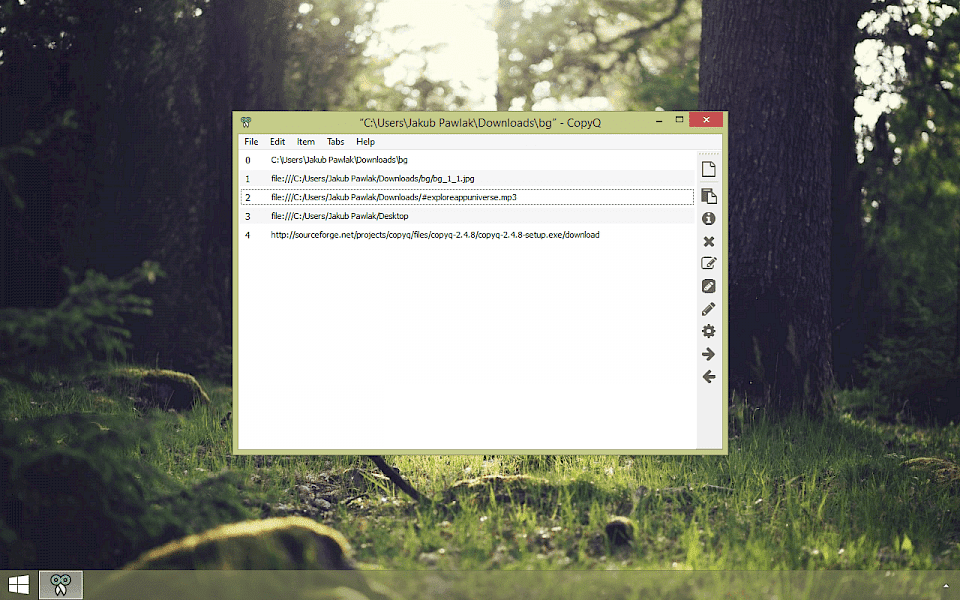
Make an entry the active clipboard content.Pinning entries to a position, and adding flags to entries.The actual clipboard manager comes up when you click the ‘ Show/Hide‘ option in the quick-access toolbar. are also accessible through the tray icon. The other options, such as the clipboard manager, the preferences window, etc. These entries are preserved over a reboot unless configured otherwise or deleted by the user. Everything that you copy remains there and can be used as the active copied text just with a click. The clipboard can be easily accessed using the top bar. X Selections, Cut Buffers, and Kill Rings.Other important features include: Easy access to Clipboard.xcmenu - Clipboard synchronizer developed for window manager users.xclipboard - Official X clipboard command-line client.Qlipper - Lightweight and cross-platform clipboard history applet based on Qt.It has both a command line and GUI mode available. Parcellite - Lightweight yet feature-rich clipboard manager.

#Copyq tutorial full#
Klipper - Full featured clipboard manager for the KDE desktop.Greenclip - Simple clipboard manager to be integrated with rofi.Offers a GNOME Shell extension and a CLI interface. GPaste - Clipboard management system that aims at being a new generation Parcellite, with a modular structure split in a couple of libraries and a daemon for adaptability.CopyQ - Clever Qt clipboard manager with searchable and editable history, custom actions on items and command line support.

Clipster - A lightweight, command-line-driven clipboard manager, written in Python.Clipmenu - Dmenu based clipboard manager.ClipManager - Cross-platform clipboard manager written in Python and Qt.It is able to handle text and images, and has a feature to execute actions on specific text selections by matching them against regular expressions. It keeps the clipboard contents around while it is usually lost when you close an application. Clipman - Clipboard manager plugin for the Xfce4 panel.Clipcat - Clipboard manager written in Rust.|| gnome-shell-extension-clipboard-indicator-git AUR Adds a clipboard indicator to the top panel, and caches clipboard history. Clipboard Indicator - Clipboard manager extension for GNOME Shell.Autocutsel - Command line and daemon interfaces to synchronize PRIMARY, CLIPBOARD and cut buffer selections.Anamnesis - Clipboard manager that stores all the clipboard history and offers an interface to do a full-text search.This section lists clipboard managers which provide additional features such as clipboard history or synchronization. Tip: Clipboards on Wayland can be synchronized with wl-clipboard using wl-paste -pw wl-copy. If you want the word to be preserved after closing terminal window, consider installing a clipboard manager. For example, if you select some word in a terminal window, close the terminal and then want to paste it somewhere else, it will not work because the terminal is gone and the text has not been copied anywhere.

It is also important to realize that according to the selection protocols, nothing is copied until it is pasted. See the Keyboard shortcuts page which lists the default shortcuts in many programs. This prevents inconsistencies in the operation of the selections. Rather than the old "cut buffers" system where arbitrary applications could modify data stored in the cut buffers, only one application may control or "own" a selection at one time. Despite the naming, all three selections are basically "clipboards". While ICCCM also defines a SECONDARY selection, it does not have a consensually agreed upon purpose. The majority of programs for Xorg, including Qt and GTK applications, follow this behavior. Unlike PRIMARY, it can also handle multiple data formats. Hence, it behaves like the single-clipboard system on Windows. CLIPBOARD Used for explicit copy/paste commands involving keyboard shortcuts or menu items. In some cases, pasting is also possible with a keyboard shortcut. Cut buffers are long deprecated, and although some applications (such as xterm) may have legacy support for them, it is both not likely and not recommended that they be used.į describes the two main selections as follows: PRIMARY Used for the currently selected text, even if it is not explicitly copied, and for middle-mouse-click pasting. However, they were inefficient and implementation of them varied, so selections were introduced. These were limited buffers that stored arbitrary text and were used by most applications.


 0 kommentar(er)
0 kommentar(er)
